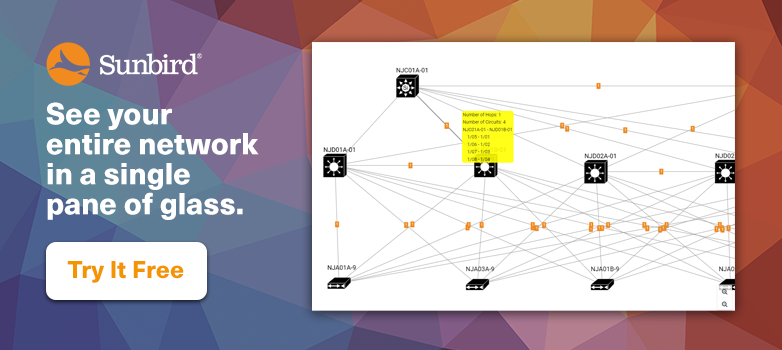A network topology diagram is a visual representation of a network’s devices, connections, and paths, allowing you to picture how devices are interconnected and how they communicate with one another. Network diagrams are typically made to represent one or all of the first three network layers (physical, data link, and network) according to the Open Systems Interconnection (OSI) model, collectively known as the media layers.
Different topologies have different impacts on performance and stability. The most common topologies are:
- Bus topology. All devices are connected by one central cable with two endpoints. It is simple and affordable, but vulnerable to downtime for the entire network with difficult troubleshooting.
- Ring topology. Devices are connected in a circular pattern. The network can run faster than in a bus topology and terminators are unnecessary, but a single failure disrupts the entire network and is hard to troubleshoot.
- Star topology. A common topology for larger networks. All data passes through a central hub which connects to all other network devices. It is reliable unless the central hub fails, but it can be expensive to set up and use.
- Mesh topology. A reliable topology where the devices are interconnected and data is transmitted by routing (sent the shortest distance) and flooding (sent to all devices). Since there can be no single point of failure, it is reliable and secure, but it’s complexity results in high costs and lengthy configuration.
- Hybrid topology. A network that is comprised of two or more topologies. Most commonly found in larger enterprises, hybrid topologies offer flexibility and scalability with the downside of often being complex, difficult to manage, and expensive.
Why You Need Network Topology Diagrams
Network topology diagrams are used to visually represent a network’s devices and connections, allowing you to picture how devices are devices communicate with each other.
Network diagrams help improve:
- Uptime. Accurate network documentation enables quick diagnosis in the event of network issues or planned maintenance.
- Efficiency. A real-time view of your network helps you maximize the utilization of your existing capacity and forecast when you will run out of capacity.
- Productivity. Reliable network diagrams allow you to save time troubleshooting issues and deploying new equipment so you can focus on more strategic projects.
Top Challenges of Documenting Network Topologies
Spreadsheets and drawing tools are commonly used for network documentation, but they are:
- Time-consuming. Network topology diagrams must be manually updated every time you move, add, or change equipment. Resources need to be spent on this job instead of more productive work.
- Inaccurate. When network diagrams are updated manually, human error is bound to occur. Inaccurate data can lead to costly downtime and stranded capacity.
- Difficult to manage. Poor version control results in different team members having different documentation and data. Poor data sharing and collaboration practices can wreak havoc across your organization.
Automatically Generate Complete Network Diagrams
Data Center Infrastructure Management (DCIM) software automatically renders network topology diagrams so you can visualize your entire network in a single pane of glass.
You can filter by types of equipment, click any node to highlight connections to other nodes, see details of assets and connections, edit the layout, and drill down to see circuit trace diagrams. You can even view a tiered layout where the devices are organize by core network, distribution network, and access network.
Automatic network diagrams greatly decrease the time spent troubleshooting and performing impact analysis. Modern DCIM tools make it easy to visualize what's connected to what, across both active and passive (i.e., patch panels and structured cabling), and across all sites.
Want to see try Sunbird's automatic network diagrams? Get your free test drive now!
Related Images/Videos
Related Links
- Network Topology and Diagrams: Everything You Need to Know
- What is Network Documentation?
- How to Improve Data Center Network Documentation [Free Excel Template]
- Data Center Connectivity Management
- 7 Best Practices for Simplifying Data Center Cable Management
- Data Center Connectivity Management Software





























